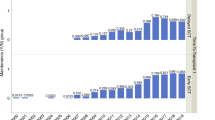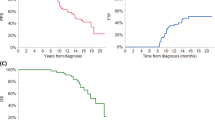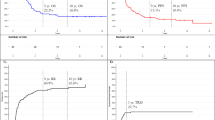Abstract
Clinical outcomes were assessed in 68 consecutive patients with multiple myeloma of high or intermediate tumor mass that had responded to VAD or dexamethasone-based therapy and were consolidated with early intensive therapy and autologous stem cell transplantation. Results were compared with those of 50 comparable patients who refused or were unable to receive intensive treatment for socioeconomic reasons. Following high-dose therapy, the rate of CR increased from 6 to 37%, with median survival prolonged by 10 months. Survival of 21 patients with disease converted from PR to CR (median 8.3 years) was significantly longer than that of similarly-treated patients who remained in PR (median 5.0 years). CR of myeloma represents the major surrogate marker of long survival and the primary goal of myeloablative treatment for patients in PR. Twelve of 18 patients with rapid reduction of myeloma protein (T½ < 0.5 months), and myeloma protein reduction to <1.0 g/dl after primary therapy achieved CR (67%), identifying pretransplant features favorable to intensive therapy. Among 35 patients with slower reduction or higher residual myeloma protein, CR occurred in eight patients (23%) (P < 0.01), for whom other treatments should be considered. The kinetics of response to initial therapy should be considered in selecting patients more likely to achieve CR and consequent long survival after intensive treatment. Bone Marrow Transplantation (2001) 27, 1037–1043.
This is a preview of subscription content, access via your institution
Access options
Subscribe to this journal
Receive 12 print issues and online access
$259.00 per year
only $21.58 per issue
Buy this article
- Purchase on Springer Link
- Instant access to full article PDF
Prices may be subject to local taxes which are calculated during checkout



Similar content being viewed by others
References
Barlogie B, Alexanian R, Dicke K et al. High dose chemoradiotherapy and autologous bone marrow transplantation for resistant multiple myeloma Blood 1987 70: 868–872
Cunningham D, Pazares L, Gore M et al. High-dose melphalan and autologous bone marrow transplantation as consolidation in previously untreated multiple myeloma J Clin Oncol 1994 12: 759–763
Alexanian R, Dimopoulos M, Hester J et al. Early myeloablative therapy for multiple myeloma Blood 1994 84: 4278–4282
Harousseau J, Attal M, Divine M et al. Autologous stem cell transplantation after first remission induction treatment in multiple myeloma Blood 1995 85: 3077–3085
Attal M, Harousseau J, Stoppa J et al. Autologous bone marrow transplantation versus conventional chemotherapy in multiple myeloma New Engl J Med 1996 335: 91–97
Bensinger W, Rowley S, Demirer T et al. High-dose therapy followed by autologous hematopoietic stem-cell infusion for patients with multiple myeloma J Clin Oncol 1996 14: 1447–1456
Barlogie B, Jagannath S, Vesole D et al. Superiority of tandem autologous transplantation over standard therapy for previously untreated multiple myeloma Blood 1997 89: 789–793
Fermand J-P, Chevret S, Ravaud P et al. High dose therapy and autologous blood stem cell transplantation in multiple myeloma Blood 1998 92: 3191–3196
Blade J, San Miguel J, Fontanillas M et al. Survival of multiple myeloma patients who are potential candidates for early high-dose therapy intensification/autotransplantation who were conventionally treated J Clin Oncol 1996 14: 2167–2173
Fermand J-P, Ravaud P, Katsahian S et al. High dose therapy and autologous blood stem cell transplantation versus conventional treatment in multiple myeloma Blood 1999 94: 396a (Abstr. 1754)
Tricot G, Barlogie B, Jagannath S et al. Poor prognosis in multiple myeloma is associated only with partial or complete deletions of chromosome 13 and not with other karyotype abnormalities Blood 1995 86: 4250–4256
Lahuerta J, Martinez-Lopez J, de la Serna J et al. Remission status defined by immunofixation vs electrophoresis after autologous transplantation has a major impact on the outcome of multiple myeloma patients Br J Haematol 2000 109: 438–446
Alexanian R, Barlogie B, Tucker S . VAD-based regimens as primary treatment for multiple myeloma Am J Hematol 1990 33: 86–89
Alexanian R, Dimopoulos M, Delasalle K, Barlogie B . Primary dexamethasone treatment of multiple myeloma Blood 1992 80: 887–890
Dimopoulos M, Weber D, Kantarjian H et al. HyperCVAD for VAD-resistant multiple myeloma Am J Hematol 1996 52: 77–81
Dimopoulos M, Alexanian R, Przepiorka D et al. A new preparative regimen for autologous marrow or blood stem cell transplantation in high-risk multiple myeloma Blood 1993 82: 2324–2328
Giralt S, Weber D, Colome M et al. Phase I trial of cyclosporine-induced graft-versus-host disease in patients with multiple myeloma undergoing high-dose chemotherapy with autologous stem cell rescue J Clin Oncol 1997 15: 667–673
McLaughlin P, Alexanian R . Myeloma protein kinetics following chemotherapy Blood 1982 60: 851–855
Siegel D, Desikan K, Mehta J et al. Age is not a prognostic variable with autotransplants for multiple myeloma Blood 1999 93: 51–54
Lenhoff S, Hjorth M, Holmberg E et al. Impact on survival of high-dose therapy with autologous stem cell support in patients younger than 60 years with newly diagnosed multiple myeloma Blood 2000 95: 7–11
Harousseau J, Facon T, Moreau P et al. Comparison of high-dose melphalan 140 mg/m2 plus total body irradiation and high-dose melphalan 200 mg/m2 as conditioning regimen for peripheral blood progenitor cell autotransplantation in patients with newly diagnosed multiple myeloma Blood 1999 94: 713a (Abstr. 3150)
Champlin R, Giralt S, Eary J et al. 166Holmium-DOTMP in combination with melphalan with or without total body irradiation as a preparative regimen for autologous stem cell transplant for patients with multiple myeloma Blood 1999 94: 709a (Abstr. 3133)
Giralt S, Weber D, Aleman A et al. Non myeloablative conditioning with fludarabine/melphalan for patients with multiple myeloma Blood 1999 94: 347a (Abstr. 1549)
Stewart A, Schiller G, Vescio R et al. CD34 selection does not prolong disease free or overall survival in myeloma patients undergoing autologous stem cell transplant Blood 1999 94: 714a (Abstr. 3151)
Osterborg A, Yi Q, Henriksson L et al. Idiotype immunization combined with granulocyte–macrophage colony-stimulating factor in myeloma patients induced type 1, major histocompatibility complex-restricted, CD8- and CD4-specific T-cell responses Blood 1998 91: 2459–2464
Singhal S, Mehta J, Desikan R et al. Antitumor activity of thalidomide in refractory multiple myeloma New Engl J Med 1999 341: 1565–1571
Acknowledgements
We thank Rose Guevara for the careful preparation of the manuscript. This work was supported by the Lucille Murchison and Kay Laro research funds.
Author information
Authors and Affiliations
Rights and permissions
About this article
Cite this article
Alexanian, R., Weber, D., Giralt, S. et al. Impact of complete remission with intensive therapy in patients with responsive multiple myeloma. Bone Marrow Transplant 27, 1037–1043 (2001). https://doi.org/10.1038/sj.bmt.1703035
Received:
Accepted:
Published:
Issue Date:
DOI: https://doi.org/10.1038/sj.bmt.1703035
Keywords
This article is cited by
-
Benefits of additional cycles of bortezomib/thalidomide/dexamethasone (VTD) induction therapy compared to four cycles of VTD for newly diagnosed multiple myeloma
Bone Marrow Transplantation (2019)
-
Impact of CR before and after allogeneic and autologous transplantation in multiple myeloma: results from the EBMT NMAM2000 prospective trial
Bone Marrow Transplantation (2015)
-
Pattern of relapse and progression after autologous SCT as upfront treatment for multiple myeloma
Bone Marrow Transplantation (2014)
-
Value of novel agents and intensive therapy for patients with multiple myeloma
Bone Marrow Transplantation (2014)
-
Phase II trial of high-dose topotecan, melphalan and CY with autologous stem cell support for multiple myeloma
Bone Marrow Transplantation (2011)



